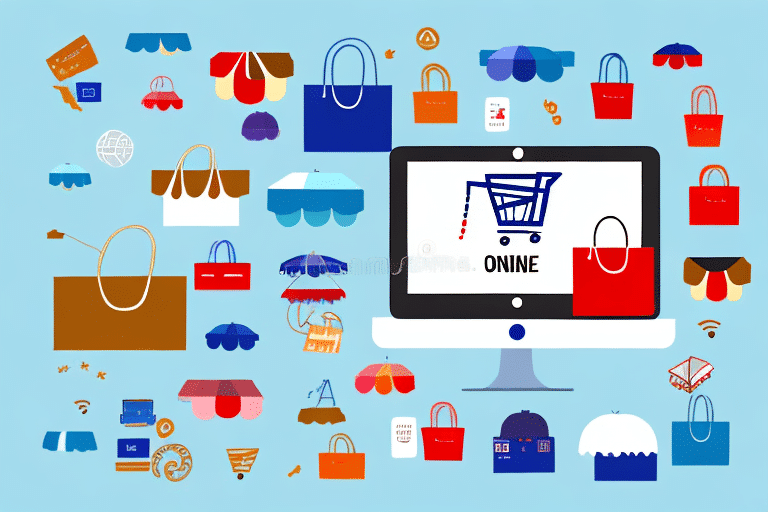Understanding E-Commerce and Its Importance in the Modern Economy
E-commerce, or electronic commerce, refers to the buying and selling of products and services over the internet using electronic platforms. It has become a cornerstone of the modern economy, disrupting traditional retail models and offering businesses and consumers unprecedented convenience and accessibility. According to Statista, global e-commerce sales surpassed $5 trillion in 2022, highlighting its significant role in global commerce.
One key advantage of e-commerce is its ability to transcend geographical boundaries, allowing businesses to reach a global customer base without the constraints of physical storefronts. This expanded market reach not only increases potential sales but also offers consumers access to a wider range of products and services.
Furthermore, e-commerce enables businesses to collect and analyze customer data, providing insights into purchasing behaviors and preferences. This data-driven approach facilitates personalized marketing strategies, enhancing customer engagement and satisfaction. The cost-effectiveness of e-commerce, due to lower overhead costs compared to traditional retail, also contributes to its growing adoption among businesses of all sizes.
The Evolution of E-Commerce Websites
The evolution of e-commerce websites has been rapid, shaped by advancements in technology and changing consumer behaviors. From simple online catalogs in the early days of the internet, e-commerce platforms have transformed into sophisticated, user-friendly portals offering personalized shopping experiences.
Historically, the introduction of secure payment systems and reliable logistics solutions were pivotal in building consumer trust and enabling the boom of online shopping. The rise of mobile commerce (m-commerce) in recent years has further revolutionized e-commerce, with mobile-friendly websites and apps allowing consumers to shop anytime, anywhere. According to the Ecommerce Foundation, m-commerce accounted for approximately 73% of e-commerce sales globally in 2023, underscoring the importance of mobile optimization.
Additionally, the integration of artificial intelligence (AI) and machine learning has enabled more personalized and efficient e-commerce experiences. Features such as chatbots, predictive analytics, and personalized recommendations have enhanced customer interactions and streamlined the shopping process.
Types of E-Commerce Websites
E-commerce websites can be broadly classified into four main categories: Business-to-Business (B2B), Business-to-Consumer (B2C), Consumer-to-Consumer (C2C), and Consumer-to-Business (C2B). Each type serves different purposes and caters to distinct audiences.
Business-to-Business (B2B)
B2B e-commerce websites facilitate transactions between businesses. These platforms typically offer bulk purchasing options, negotiated pricing, and features tailored to meet the needs of organizational buyers. B2B transactions often involve higher order values and longer sales cycles compared to B2C.
Business-to-Consumer (B2C)
B2C e-commerce websites are designed to sell products or services directly to individual consumers. They feature user-friendly interfaces, diverse product catalogs, competitive pricing, and various payment options to attract and retain customers. Examples include online retailers like Amazon and Walmart.
Consumer-to-Consumer (C2C)
C2C e-commerce websites serve as platforms where individual consumers can buy and sell products or services to one another. These platforms, such as eBay and Craigslist, often operate by charging a commission or listing fees for transactions facilitated through their site.
Consumer-to-Business (C2B)
C2B e-commerce websites allow consumers to offer products or services to businesses. This model includes freelance marketplaces like Upwork and Fiverr, where businesses can hire individuals for specific projects or services.
Niche E-Commerce Websites and Their Advantages
Niche e-commerce websites focus on specific market segments or product categories, catering to a targeted audience with specialized needs. Examples include eco-friendly product stores, custom apparel shops, and specialty food retailers. According to Forbes, niche e-commerce businesses often enjoy higher customer loyalty and lower competition, allowing them to establish a strong brand presence within their specific market.
Advantages of niche e-commerce websites include:
- Personalized Shopping Experiences: Tailored product offerings and marketing strategies that resonate with the specific needs and preferences of the target audience.
- Customer Loyalty: A focused product range can foster a community of dedicated customers who return for specialized products.
- Competitive Advantage: Reduced competition within niche markets allows businesses to differentiate themselves more effectively.
- Higher Profit Margins: Specialized products can often command premium pricing, resulting in better profit margins.
Essential Components of E-Commerce Websites
Successful e-commerce websites are built upon several key components that ensure a seamless and secure shopping experience. These include:
E-Commerce Platforms
E-commerce platforms are software solutions that facilitate online sales and manage various aspects of e-commerce operations. Popular platforms include:
- Shopify – Known for its user-friendly interface and extensive app ecosystem.
- Magento – A robust platform suitable for large-scale businesses requiring extensive customization.
- BigCommerce – Offers scalability and a wide range of built-in features.
- WooCommerce – A flexible plugin for WordPress sites, ideal for small to medium-sized businesses.
- Squarespace – Provides visually appealing templates for creatives and small businesses.
Choosing the right platform depends on factors such as business size, budget, customization needs, and technical expertise.
Payment Gateways
Payment gateways are crucial for facilitating secure online transactions. They act as intermediaries between customers' payment methods and the businesses' bank accounts. Some reputable payment gateways include:
Choosing a reliable payment gateway is essential for ensuring transaction security, reducing fraud, and providing a smooth checkout experience for customers.
Common Challenges and Solutions in E-Commerce
Operating an e-commerce website comes with its own set of challenges. Understanding these obstacles and implementing effective solutions is crucial for maintaining a successful online business.
Security Breaches
Security is a major concern for e-commerce websites, as breaches can lead to the loss of customer trust and financial data. To mitigate this risk:
- Implement SSL certificates to encrypt data.
- Use secure and reputable payment gateways.
- Regularly update software and plugins to patch vulnerabilities.
- Conduct regular security audits and compliance checks.
Website Performance
Slow-loading websites can deter customers and hurt search engine rankings. To ensure optimal website performance:
- Optimize images and multimedia content for faster load times.
- Use content delivery networks (CDNs) to distribute content efficiently.
- Minimize the use of heavy scripts and plugins.
- Ensure your hosting service can handle high traffic volumes.
Cart Abandonment
Cart abandonment is a common issue in e-commerce, where potential customers leave products in their shopping carts without completing the purchase. Strategies to reduce cart abandonment include:
- Streamline the checkout process to minimize steps and required information.
- Offer multiple payment options to accommodate different customer preferences.
- Provide clear shipping information and transparent pricing.
- Implement retargeting campaigns to remind customers of their abandoned carts.
Inventory Management
Effective inventory management is vital to prevent stockouts and overstocking, which can impact sales and profitability. Solutions include:
- Use inventory management software to track stock levels in real-time.
- Implement automated reorder points to maintain optimal inventory levels.
- Integrate your e-commerce platform with suppliers for seamless stock updates.
Future Trends in E-Commerce
The e-commerce landscape is continuously evolving, driven by technological advancements and shifting consumer behaviors. Staying ahead of these trends is crucial for businesses to remain competitive and meet customer expectations. Key trends to watch in 2023 and beyond include:
Mobile Commerce (M-Commerce)
With the growing use of smartphones, m-commerce continues to dominate the e-commerce space. Ensuring mobile-responsive websites and offering mobile-specific features like one-click purchasing are essential strategies.
Artificial Intelligence and Machine Learning
AI and machine learning are transforming e-commerce by enabling personalized recommendations, predictive analytics, and automated customer service through chatbots. These technologies enhance the shopping experience and improve operational efficiency.
Augmented Reality (AR) and Virtual Reality (VR)
AR and VR technologies provide immersive shopping experiences, allowing customers to visualize products in real-world settings before making a purchase. This trend is particularly impactful in industries like fashion, home decor, and automotive.
Social Commerce
Integration of e-commerce functionalities within social media platforms is increasing, making it easier for consumers to purchase products directly through their favorite social networks. This trend leverages the power of social proof and influencer marketing to drive sales.
Sustainable and Ethical E-Commerce
Consumers are increasingly prioritizing sustainability and ethical practices when making purchasing decisions. E-commerce businesses are responding by offering eco-friendly products, transparent supply chains, and sustainable shipping options.
Best Practices for Creating a Successful E-Commerce Website
Building a successful e-commerce website requires careful planning and execution across several key areas:
Website Design and User Experience
A user-friendly design that is easy to navigate can significantly enhance the customer experience. Focus on clear navigation menus, intuitive search functionality, and responsive design that works well across all devices.
Search Engine Optimization (SEO)
Implementing effective SEO strategies is essential for improving your website's visibility on search engines. This includes optimizing product pages with relevant keywords, creating high-quality content, and ensuring fast load times.
Content Marketing
Creating valuable and informative content, such as blog posts, how-to guides, and product reviews, can attract and engage potential customers. Content marketing also helps establish your brand as an authority in your industry.
Customer Engagement and Retention
Building strong relationships with customers through personalized marketing, loyalty programs, and excellent customer service leads to higher retention rates. Engaging customers through email marketing, social media, and interactive features enhances loyalty and encourages repeat business.
Security and Trust
Ensuring your website is secure and trustworthy is critical for gaining customer confidence. Display security badges, offer secure payment options, and maintain transparent privacy policies to reassure customers that their information is safe.
Case Studies: Top 10 Successful E-Commerce Websites and Their Secrets to Success
Several e-commerce websites have set benchmarks in the industry through their innovative approaches and exceptional performance. Here are ten of the most successful e-commerce websites globally and the factors that contribute to their success:
- Amazon: Known for its vast product selection, fast shipping, and customer-centric approach.
- Alibaba: Dominates the B2B e-commerce space with a comprehensive platform connecting global suppliers and buyers.
- Walmart: Combines physical and online retail to offer a seamless omnichannel shopping experience.
- eBay: Pioneered the C2C model with its auction-based platform, providing a marketplace for diverse products.
- Etsy: Specializes in handmade and vintage items, fostering a community of creative sellers and buyers.
- Shopify: Empowers small to medium-sized businesses with customizable e-commerce solutions.
- Zalando: A leading European fashion e-commerce platform with a strong focus on customer service and logistics.
- SeaShop (Shopee): Grows rapidly in Southeast Asia through mobile-first strategies and localized marketing.
- Rakuten: Integrates loyalty programs and a wide range of services to enhance customer engagement.
- ASOS: Targets the young demographic with trendy fashion offerings and a strong online presence.
These websites stand out due to their relentless focus on customer satisfaction, innovative use of technology, and ability to adapt to changing market dynamics. By studying their strategies, other e-commerce businesses can glean valuable insights to drive their own success.
Conclusion
E-commerce has fundamentally transformed the way businesses operate and how consumers shop. Understanding the various types of e-commerce websites, the essential components for success, common challenges, and emerging trends is crucial for any business looking to thrive in the digital marketplace. By leveraging the right platforms, optimizing for user experience and SEO, and staying abreast of technological advancements, businesses can harness the full potential of e-commerce to drive growth and achieve long-term success.






















